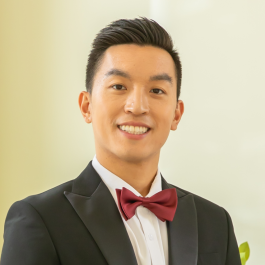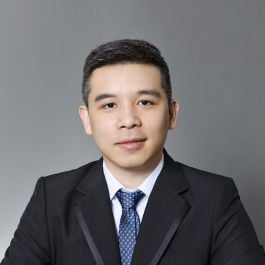In a playground's sandbox, a child's hands conjure a castle with ivy-covered towers and turrets shrouded in clouds. While an onlooker would only see the foundations of their imagination, all the child sees before them is possibility.
Terence Chan recently saw the future in a different type of sandbox — the technical kind used by software engineers to explore new ideas.
Last year, Chan, a software engineer, took part in a hackathon hosted by his employer, Motorola Solutions — an experience that allowed him to do what engineers love to do most: experiment.
“We were using new technologies that we were all interested in, so it was a nice sandbox for us to play around in while applying it to an actual problem that our company can help solve,” Chan said.
The problem that Chan was referring to is the need to strengthen public safety, which defines the ethos of Motorola Solutions. He explained that the solution he and his peers came up with, which proved to be the winning idea of the hackathon, enables public safety personnel to upload any evidence as either audio or video into a software platform to get a better understanding of a situation, empowering them to respond more effectively and quickly.
While specifics about the winning solution cannot be disclosed — the idea was so good, it’s being added to the company’s product roadmap — the skill and teamwork that has gone into building it is a story in itself. According to JavaScript/Python Developer John Vincent Angeles, every solution that comes to life at Motorola Solutions is a reflection of the company’s culture; one defined by innovation, comprising more than 20,000 team members with diverse skills and expertise.
“Being able to have multiple perspectives leads us to be more creative in problem-solving, and we’re able to share unique ideas,” he said.
According to Angeles, many different types of professionals — from research scientists to engineers — work on his team, which means he and his peers have access to a wide range of knowledge that would be siloed in a more traditional business structure. He added that a strong focus on open communication makes this knowledge-sharing even stronger, unlocking an arsenal of expertise that enables them to take their technology to the next level.
“Many different types of professionals — from research scientists to engineers — work on Angeles’ team, which means he and his peers have access to a wide range of knowledge that would be siloed in a more traditional business structure.”
With a degree in biomedical engineering, Chan’s own path to software engineering was nontraditional, yet he has never been expected to fit a certain mold during his time at the company; rather, the greatest expectation is to be agile.
“As long as you’re able to learn and think on your feet, you’re always welcome,” Chan said.
When it comes to disseminating this diverse breadth of expertise, Chan shared, team members can do so through various means, including research seminars. During past seminars, team members have presented new research papers related to machine learning, allowing everyone to stay up to date on the latest industry trends.
This knowledge-sharing also happens on an even smaller scale. Angeles noted that he and his team members share updates with each other every Thursday, offering insight into what they accomplished and learned during the week. Having this level of consistent communication is important, Chan added, considering team members are located across North America.
“We’re pretty spread out, but we have weekly syncs so we’re on the same page,” he said. “Since everyone is quite responsive, it doesn’t feel like we’re fully remote.”
Connected With Customers
According to Chan, having a close connection with Motorola Solutions’ customers helps bridge the gap between ideas and actions, giving technologists the insight they need to deliver products with optimal impact. For him, getting to see this influence firsthand is both humbling and a reflection of the company’s startup-like nature.
“Getting feedback that we helped a customer improve their overall workflow efficiency — that’s always nice to hear,” he said. “Even though we’re quite a large company, we do have that close connection to our customers.”
By staying in sync, Chan and his peers get to focus on what matters most: building cutting-edge solutions that help solve real-world safety and security challenges. In his mind, this undertaking is made easier by his team’s unique position as the company’s unofficial “AI department.”
“We’re encouraged to think of and brainstorm some of these more novel features and ideas,” Chan said.
But what’s even better, he added, is that the company’s product managers involve his team early on during projects. Rather than simply including managers in critical conversations, PMs will often confer with the company’s research scientists to find common ground.
“If you have an idea that you feel could impact the company, you’re always welcome to contribute it to any discussions,” Chan said.
With such a strong focus on creative brainstorming, one may wonder: When do team members find the time to do this? According to Angeles, he and his peers follow a “10-percent time” policy, which allows team members to spend 10 percent of their time on researching and building upon ideas that fall outside of their day-to-day responsibilities.
Having the freedom to explore ideas, whether directly related to their day-to-day work or an outside passion, not only enables Angeles and his peers to drive progress, it helps them connect with their jobs on a deeper level.
“Personally, it helps me feel valued and empowered,” he said. “I feel like I’m contributing to the company's present and future.”
“I feel like I’m contributing to the company’s present and future.”
For Chan, the work the company does to help safeguard communities around the world — a sentiment captured in the company’s Solving for safer narrative — is enough to compel any technologist to join the team. Because with the encouragement to leverage the latest technologies and pursue work with real-world influence, what more could anyone ask for?
“With the kind of work that we’re doing, we’re making high-impact solutions that can be reached by our public safety professionals,” Chan said. “Being in the AI space — where we get to help reduce that gap even further — is the icing on the cake.”







